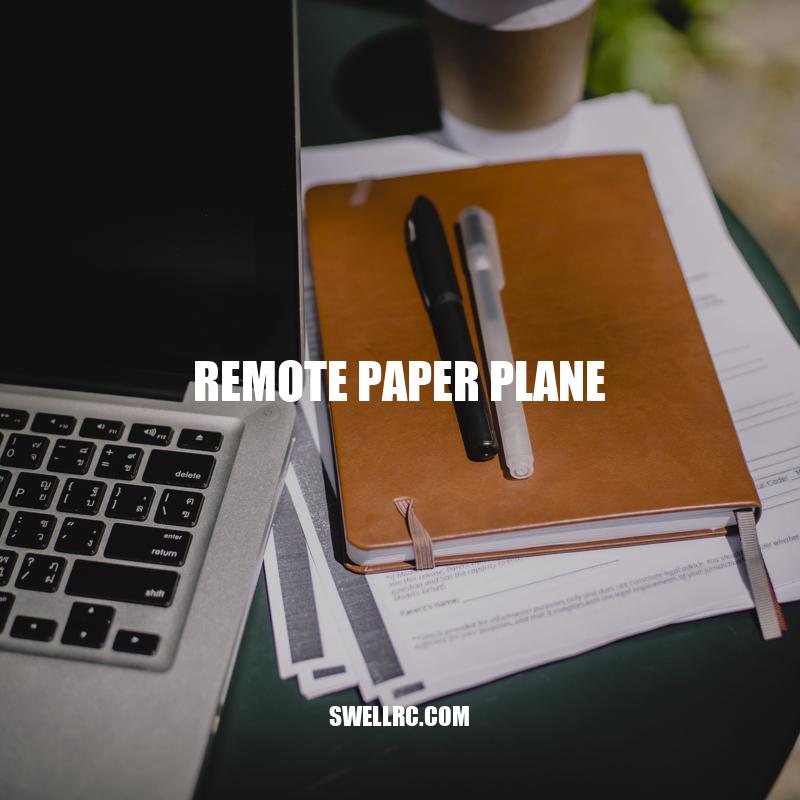Remote Paper Planes: Tips for Making and Flying
Remote paper planes have become a popular pastime among kids and adults alike. These miniature flying machines are built entirely from paper and operated with a remote control, offering an innovative way to experience the joy of flying. With a bit of creative ingenuity and some basic tools and materials, anyone can build a remote paper plane and take to the skies. But the process of creating and flying a remote paper plane requires some know-how and attention to detail. In this article, we will provide a step-by-step guide on how to make a remote paper plane, as well as tips and precautions to help ensure a safe and enjoyable flying experience. So, whether you are a seasoned remote paper plane enthusiast or a first-time flyer, follow along as we take you through the exciting world of remote paper planes.
How to Make a Remote Paper Plane
Making a remote paper plane may seem like a daunting task, but it’s actually quite simple. Here’s a step-by-step guide to help you get started:
- Gather all the materials and tools you will need, including thin paper, scissors, glue, a ruler, and a remote control.
- Create the body of the plane using origami paper or any other thin paper. Fold the paper in half, then fold it again in half to create a crease down the center.
- Take the top right corner of the fold and fold it down to the center crease. Repeat this step with the left corner.
- Turn the paper over and fold the top layer in half downwards.
- Repeat step 3 with the new bottom corners created by the fold in step 4.
- Open the folds created from steps 3-5 and fold down the top edges towards the center crease.
- Create slits in the center fold, then fold the flaps up and crease them in place.
- Attach the remote control to the paper plane. You can use a small motor and battery or a microcontroller programmed with your remote control code to operate the plane.
- Test the plane’s stability and flight path, then make any necessary adjustments.
There are many websites and products available that can offer additional guidance on creating remote paper planes. Some popular options include:
Paper Airplane World: A comprehensive website with instructions for building a variety of paper airplanes, including remote control planes.
PowerUp 3.0: A kit that allows you to add a motor and remote control to your paper airplane.
YouTube: A vast collection of videos that offer step-by-step instructions on how to make remote paper planes.
How to make a cool paper airplane?
To make a cool paper airplane, start by selecting a rectangular sheet of paper. Fold it in half vertically and then unfold it. Fold the top two corners down diagonally to meet at the center crease. Fold the top edge down to meet the bottom edge, forming a triangle. Fold the top corners in toward the center crease again, then fold the entire model in half along the center crease. Lastly, fold down the wings and enjoy your plane! For more detailed instructions and variations on this design, there are many websites and YouTube channels dedicated to paper airplane crafting such as origamiway.com and Fold’N Fly. Additionally, there are plenty of paper airplane books and kits available on websites such as Amazon and Barnes & Noble that can provide even more designs and inspiration.
Adding the Remote Control
Once you’ve created the body of your remote paper plane, the next step is to add the remote control. Here’s how to do it:
- Create the remote control using paper, cardboard, or any other lightweight and durable material.
- Attach the control to the plane using tape or glue.
- Test the remote to ensure that it’s working properly.
Did you know that remote paper planes have become so popular that there are now competitions held all over the world? These competitions involve participants creating their own remote paper planes and competing against each other in various categories such as flight time, distance, and accuracy.
If you’re interested in participating in a remote paper plane competition or simply want to learn more about the craft, there are many websites and resources available to help. Here are some of the most popular ones:
- Red Bull Paper Wings: This is a global paper airplane competition sponsored by Red Bull. It includes a variety of categories and is open to participants from all over the world.
- Paper Plane Association: This is a website dedicated to paper airplanes. It includes tutorials, tips, and information about competitions and events.
- Paper Airplane World: This website offers instructions and tutorials for creating a variety of paper airplanes, including remote control planes.
How to make your own paper airplane?
Making a paper airplane is a fun activity that can be enjoyed by people of all ages. To make your own paper airplane, start by folding a regular 8.5 x 11 inch sheet of paper in half horizontally. Next, unfold the paper and fold each of the top corners into the center line. Then, fold the peak down to meet the edge of the previous fold. After that, fold the upper sides into the center line. Following this, fold the top edge 1/2” away from you. Lastly, fold the plane in half towards you. For more detailed instructions, there are many websites and videos available online that can guide you through the process, such as Origamiway.com and PaperairplanesHQ.com.
Tips for Flying a Remote Paper Plane
Successfully flying a remote paper plane takes some practice and patience. Here are some tips to help you improve your remote paper plane flying skills:
- Select a large and open area to fly your remote paper plane. This can be a park, a field or a wide-open space with minimal obstruction.
- Avoid flying your remote paper plane in windy conditions, as it can be difficult to control or could get blown away.
- Make sure the battery of the remote control is charged before use.
- Practice making short flights initially, and gradually increase the duration of your flights as you gain more experience.
- Use gentle movements when controlling the paper plane to avoid any sudden movements that could cause it to crash.
One of the most exciting things about remote paper planes is that they come in a variety of designs and styles. From classic jets to more unique models like UFOs and dragons, there’s something for everyone. Many companies now offer remote control paper planes in a variety of designs that are easy to assemble and control, such as the PowerUp Toys range of remote control paper planes.
If you’re looking to take your remote paper plane flying skills to the next level, there are also pro-level remote paper plane kits available that offer advanced controls and features. These kits can be purchased online or from specialty hobby shops, and are perfect for those who want to compete in remote paper plane flying competitions or simply want to experience the thrill of flying an advanced remote paper plane.
How do you make a paper airplane that flies far easy?
To make a paper airplane that flies far and easy, there are various tutorials available on the internet, but the easiest and helpful guide is a YouTube video by Mahir Cave. The tutorial provides a step-by-step guide on how to fold the paper and create an aerodynamic design that can fly far and fast. Additionally, there are also websites like Fold ‘N Fly and Paper Airplane World that offer a range of paper airplane designs with folding instructions to help create the perfect plane for your needs.
Flying a remote paper plane can be an exciting experience but it’s important to take some precautions to ensure your safety and the safety of others. Here are some guidelines to follow:
- Never fly a remote paper plane near people, animals, or property.
- Make sure the batteries in the remote control are properly inserted and the plane is in good condition before starting the flight.
- Avoid flying your remote paper plane in crowded areas or near power lines.
- Keep your eyes on the plane at all times and never disturb other flyers.
- Do not fly the remote paper plane during bad weather or low visibility conditions.
It’s also important to maintain and repair your remote paper plane regularly. Here are some tips to ensure your paper plane remains in good condition:
- Store the remote paper plane in a cool and dry place to prevent dust, moisture, or damage.
- Clean the paper plane gently using a soft cloth and avoid water or harsh chemicals.
- Replace any damaged or worn-out parts immediately using a proper repair kit.
There are various websites and resources available that provide valuable information and tips on remote paper plane flying and maintenance. Websites such as PowerUp Toys and The Fold ‘N Fly offer valuable resources and tutorials for creating different types of remote paper planes and improving your flying skills.
What are the things you need to consider in flying the paper airplane?
When it comes to flying a paper airplane, it’s important to consider the forces that affect its flight: thrust, lift, drag, and gravity. The way you fold the paper airplane, the weight of the paper, and throwing technique can all impact these forces. To optimize your paper plane’s flight, experiment with different folds and adjust the wings, tail, and nose. You can also find resources online, like tutorials or paper airplane kits, to improve your technique and ultimately achieve longer, smoother flights.
Conclusion
Remote paper planes can provide a fun and inexpensive way to experience the thrill of flying. However, it’s important to follow the necessary safety measures and ensure that the plane is in good working condition before starting the flight. By adhering to the guidelines and precautions mentioned in this article, you can enjoy flying your remote paper plane while keeping yourself and others safe.
Learning to fly a remote paper plane can be a great activity for kids and adults alike. It can teach children about aerodynamics and physics while providing a fun outdoor activity. Adults can also enjoy the challenge of creating and flying intricate paper planes while also relieving stress.
Creating a remote paper plane can also be a creative and fun art project for children to do at home, especially during these times when most of us have to stay indoors. It can be an engaging activity for parents to do with their children, teaching them how to be patient while following instructions and enhancing their motor skills.
So why not create your own remote paper plane and experience the thrill of flying? All you need is some paper, a remote control, and some creativity. With a little bit of practice, you can master the art of remote paper plane flying and have hours of fun while doing it!



